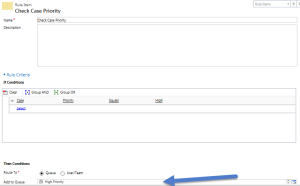Microsoft Dynamics CRM 2013 SP1 and Microsoft Dynamics CRM Online Spring ’14 introduced a new feature that allows us to define case routing rules. We can set up different queues based on different business scenarios and then define case routing rules to route cases to these queues (Note: we can have only one routing rule set active at a time). To define routing rules we can navigate to Settings -> Service Management.
Any user with appropriate permission on Routing Rule Set can create and modify routing rules.
In our scenario let say we have queues named High Priority and Low Priority (we can create new queue by navigating Settings ->Service Management->Queues) and we want to define a routing rules to rout high/low priority cases to respective queues. To create routing rule, we need to use following instructions:
- Navigate to Settings-> Service Management-> Routing Rule Set->New
- Fill routing rule set name, Let’s say “Case Assignment Rule”
- Click on Save button under command bar
- Click on plus sign on Rule Item sub grid to create rule
- Define routing rule like following screen and click on Save and Close on rule item window.
- Follow same steps to create another Rule Item to check if case priority equals to low then assign case to Low Priority queue.
- Click on Activate button on command bar of routing rule set from.
Now navigate to active case view and select single or multiple cases. After selection, we will see APPLY ROUTING RULE button on command bar, click on this button and it will rout cases based on their priority to high or low priority queue.
 Now navigate to Service -> Queue, we should be able to see all cases routed to respective queses.
Now navigate to Service -> Queue, we should be able to see all cases routed to respective queses.
HIMBAP | Need any help in Microsoft CRM 2013 Contact US !!



Very nice.
But, there does not appear to be any option to apply routing rules automatically? If one refines the case creation rules enough, they should be sufficient to apply an automatic routing rule after creation.
it should be doable with a plugin. Do you know if we canapply routing rules from .NET?
You can use ApplyRoutingRuleRequest for that, but actually there is a issue with this request, check this https://connect.microsoft.com/dynamicssuggestions/feedbackdetail/view/927712